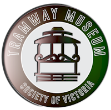Tramway Museum Society of Victoria Incorporated
38 Piccadilly Crescent, Keysborough, VIC 3173
Tramway Heritage Centre
330 Union Lane, Bylands, VIC 3762
Content copyright © Tramway Museum Society of Victoria Inc. Reproduced with permission.
ABN 12 739 015 600 Victorian Registration A1864E







Most people know that Melbourne had cable trams. In its heyday, Melbourne's system was the fourth biggest in the world with 46 miles of double track and 1,200 cable cars and trailers. Not so well known are Sydney's cable trams, for although Melbourne persisted with cable trams until 1940, Sydney gave them away for electricity in 1905. Melbourne did not have the steep hills that made cable trams so attractive in San Francisco, where Andrew Hallidie invented them in 1873. But it decided to have them just the same. They seemed more modern than Adelaide's horse trams and were certainly quieter and cleaner than Sydney's snorting steam trams. And since the cable never stopped moving, the cars could be smaller and more frequent.
Melbourne's cable cars were pleasant vehicles. Each route had its won trams painted in distinctive colours and suitably lettered with the destination. The first car in each set, called the dummy, had the gripping gear in the centre with seating all around. Except for the roof, it was quite open. The second car was more like a conventional four-
The cable ran along in a slot between the rails and was kept moving by an engine house placed somewhere along the route. Each tram has a gripper rather like and iron hand, which passed through a slit in the roadway and gripped the cable below. When the driver, or gripman as he was called, wanted the tram to go, he use on of his levers to close the gripper on the cable. To stop the tram, he simply let go of the cable and applied the brake. For this he had two other levers, one of them applied the blocks to the rails. With good weather and not too big a load these would stop the tram gently. If this did not work, he would use the other lever which applied metal brake shoes to the four wheels of the dummy. The tram proper had no power of its own, but it did have brakes.
Knowing where to grip and when to let go the cable was quite an art. When tramways crossed, as they frequently did in Melbourne's system, one cable passed beneath the other. Cars running on the lower cable had to drip it and coast over the crossing. Much the same procedure was followed at corners. At some corners the cable ran around a big drum, at others one cable had to be dropped and another picked up. In either case the cable had to be let go.
So the gripman would know when to drop the cable, white marble blocks were set into the roadway and these sometimes let up. Once the gripman dropped the cable the tam had to rely on its momentum to keep going until it picked it up again. This was all very well as long as an absent-
Melbourne's first line was built from Spencer Street, along Flinders Street and Bridge Road to Hawthorn Bridge, past of the present North Balwyn line, and over three miles in length. The engine house was at the corner of Hoddle Street and Bridge Road. Two cables ran from the engine house, one to each terminus. This line was officially opened on November 11, 1885. Other lines soon followed. One ran from Spencer Street, up Collins Street, Brunswick Street and St Georges Road, nearly four miles. it had branches around Victoria Parade and Simpson's road, another two miles. Another ran up Bourke street, along Nicholson Street, Gertrude Street, Smith Street and Heidelberg Road to Northcote Bridge. Crossing these lines other ran along Elizabeth Street and Swanston Street. The Elizabeth Street trams ran via Sydney Road to Moreland Road, Brunswick, a distance of four and a half miles. Its main section of able was 32,000 feet long. It was nearly a straight run, which was ideal.
OUR ARCHIVES

| Our History |
| Our Funding |
| Rail Safety |
| Working Bee |
| Membership |
| Reflections |
| Previous Issues |
| Media |
| 2011 |
| 2010 |
| 2009 |
| 2007 |
| 2006 |
| 2005 |
| 2004 |
| 2003 |
| 2002 |
| 2001 |
| 2000 |
| 1999 |
| 1998 |
| 1997 |
| 1996 |
| 1995 |
| 1990 |
| 1989 |
| 1988 |
| 1987 |
| 1986 |
| 2011 |
| 2010 |
| 2009 |
| 2007 |
| 2006 |
| 2005 |
| 2004 |
| 2003 |
| 2002 |
| 2001 |
| 2000 |
| 1999 |
| 1998 |
| 1997 |
| 1996 |
| 1995 |
| 1990 |
| 1989 |
| 1988 |
| 1987 |
| 1986 |
| 1964-1965 |
| 1965-1966 |
| 1966-1967 |
| 1967-1968 |
| 1968-1969 |
| 1969 |
| 1972 |
| 1973 |